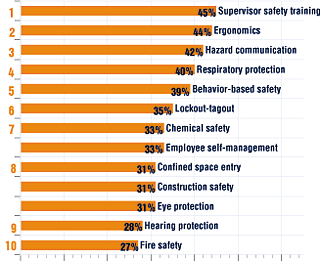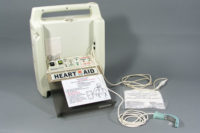

About one-third of the readers (34 percent) responding to ISHN’s survey conduct 25 or more safety training sessions a year — averaging at least two per month. Another 42 percent hold anywhere from six to 24 sessions.
Use this summary of the survey to compare your training plans and methods to other readers. One thousand readers were mailed questionnaires with 187 responding, for a 19 percent response rate.

Who's develops training?
If OSHA compliance is “Job One” for safety and health pros, then training is “Job One-A.” In 76 percent of the facilities we surveyed, it’s the safety and health manager, director, or coordinator’s job to put together training content.Despite all the calls for worker empowerment and involvement, only about one-third (34 percent) of surveyed facilities use employees and/or employee teams to develop training materials. Consultants are called on by about one-quarter (27 percent) of facilities.

Training tools
Traditional methods rule when it comes to safety and health training. Videos are far and away the most common tool, used by nearly everyone — 86 percent of those surveyed. And despite the buzz about “distance learning” via satellites and the Internet, 77 percent will travel to seminars and workshops this year.Other popular means of delivering training have been around for decades, too: •
- Posters (used by 55 percent of safety pros); •
- Employee newsletters (used by 48 percent); •
- Hiring outside trainers and consultants (used by 39 percent).
New technology tools are catching on, but still have a way to go. About one in four facilities (28 percent) make use of CD-ROM training material. Safety and health training programs delivered from a company’s internal Web server — Intranet-based training — is a strategy employed by 18 percent of the safety and health pros we surveyed. That’s almost twice as popular right now as accessing training programs from a public server — Internet-based training — which is done by ten percent of those surveyed.
Not surprisingly, these newer delivery methods will become more common in the future. Twenty-five percent of safety and health pros say they plan to use Internet-based training in the next three years, up from the current ten percent. Thirty-six percent plan to use CDs, up from 28 percent. And Intranet-based training is expected to grow from 18 percent to 32 percent of those surveyed.
Cost per employee
Almost one-half of the facilities surveyed (44 percent) spend $100 or less per employee annually for safety and health training. Twenty-eight percent spend $101 - $500 per employee; 14 percent spend $501 - $1,000; and 14 percent spend more than $1,000 per year on each employee.Top training topics
Last fall, ISHN asked readers for their safety and health priorities in 2000 — a good indication of where they’ll put their training efforts. Here are the top ten topics: See chart 1
Off-the-job training
Many companies periodically cover off-the-job safety and health issues in training programs. Here are the top five concerns, according to readers surveyed last fall: See chart 2
Managing records
Almost everyone has a system for managing training records — only one percent of those responding to our April survey admitted to not keeping track of training. The most typical method is a mix of both software and paper files — used by 55 percent of those surveyed. Paper-only documentation is used by 49 percent. Looks like it will be a while before safety training record-keeping contributes to the paperless office: only 32 percent of respondents use strictly computerized records.
Online training
Web-based safety and health training is expected to increase in the next few years, but right now, only 15 percent of the safety and health pros surveyed say they are using online training products (Internet or Intranet). Most of these “leading edge” respondents (61 percent) say they “prefer traditional methods but are experimenting with online products.”Still, two-thirds of those we surveyed say they are at least considering online training products. So what’s driving the interest? We asked readers to tell us why they are using, or considering using, online products. Clearly, the number one factor is flexibility — being able to train employees anytime, anywhere. It was cited by 57 percent of respondents, far outpacing any other reason given.
The lure of lower prices, a big draw in consumer online shopping, isn’t much of an attraction. Potential cost savings through online training was cited by only 33 percent. And top managers aren’t forcing the issue. Only four percent of respondents say their corporate management is pushing online training.
What's it good for?
Safety and health topics that need to be presented on a repeat basis are best-suited for online delivery, according to the survey. We asked readers to tell us the best applications for online training: See chart 3Barriers to online training
Getting to the Internet is the biggest issue right now. Most workers do not have an Internet-connected computer within easy reach while working, according to the survey. Most of the safety and health pros we polled (57 percent) say less than one out of every four employees at their facility has Internet access.It’s not surprising, then, that the most common reason for not using or considering online training is an inadequate supply of computers with Internet access (cited by 50 percent of those polled). The quality of online products, lack of instructor interaction, and potential lack of student accountability are not big concerns — less than one-third of respondents mentioned these issues.
The “digital divide” between technology
“haves” and “have-nots” is apparent in safety and health. Large corporations are using customized Intranet content to deliver consistent training
messages across far-flung operations, while
small companies with limited hardware and software rely on traditional classroom and video approaches. Still, most survey respondents are
keeping an open mind to using technology, and upwards of one-third of ISHN readers will use either CDs, the Internet, or Intranets in the next three years.
Sidebar: OSHA gets into the act-grant money goes to content providers
The agency wants grant recipients to develop Internet-based diagnostic or “expert” software that can be downloaded and “walk” users through an interview-like process to profile their facility’s compliance needs. Users end up with a “to do” list to manage compliance. Information is customized for each facility and kept current over the Internet.The system must also be capable of automatically downloading, indexing, viewing, and printing material safety data sheets, according to OSHA. Once tagged, these MSDS files would be monitored and automatically updated via the Internet.
OSHA will review all software and educational materials developed for technical accuracy, and the agency reserves the right to place the content on the Internet.
